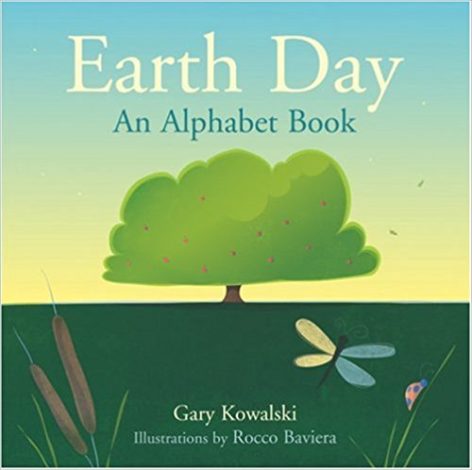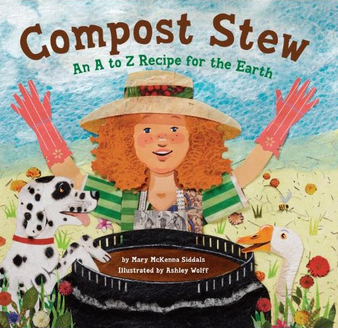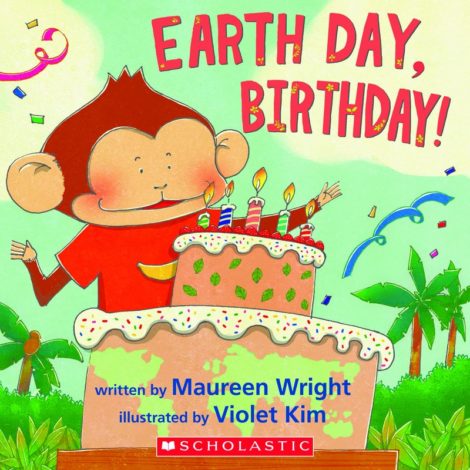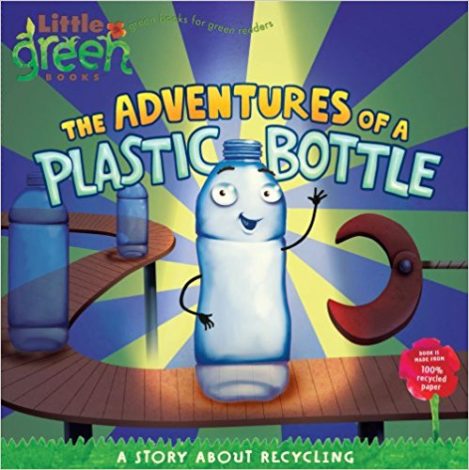Earth Day Book Reviews
Earth Day, celebrated each year on April 22, has been around since 1970. While we tend to think about recycling, caring for the earth and planting new flowers on Earth Day, there are some books you can read year-round with your children to instill a love of the earth and to teach them how to protect it.
Earth Day: An Alphabet Book by Gary Kowalski This simple alphabet book will show children various animals, plants and nature-related words for each letter of the alphabet. Simple yet colorful illustrations accompany each letter as the author creates a list of what we should be thankful for and appreciate in nature. While most of the letters present familiar words for young children, other words, like nasturtiums and persimmons, will allow for vocabulary growth in preschool-aged children.
Age recommendations: Birth through preschool
Compost Stew: An A to Z Recipe for the Earth by Mary McKenna Siddals
This simple alphabet book will show children various animals, plants and nature-related words for each letter of the alphabet. Simple yet colorful illustrations accompany each letter as the author creates a list of what we should be thankful for and appreciate in nature. While most of the letters present familiar words for young children, other words, like nasturtiums and persimmons, will allow for vocabulary growth in preschool-aged children.
Age recommendations: Birth through preschool
Compost Stew: An A to Z Recipe for the Earth by Mary McKenna Siddals
 This is an alphabet book with a twist! While still following the ABCs, items listed are "ingredients" that can be used in making compost. Rhyme and repetition are incorporated into the text, making this book a fun read aloud for younger children. The unique illustrations are collage-like and focus on recycling. Newspaper is used throughout in different ways to demonstrate how to reuse items. While the text focuses on what to include in a compost pile, there's also a note at the end of the book telling you what does not belong in a compost pile. Older children may enjoy taking the lessons of the book and creating their own compost pile with family.
Age recommendations: Toddlers through early elementary
Earth Day, Birthday! by Maureen Wright
This is an alphabet book with a twist! While still following the ABCs, items listed are "ingredients" that can be used in making compost. Rhyme and repetition are incorporated into the text, making this book a fun read aloud for younger children. The unique illustrations are collage-like and focus on recycling. Newspaper is used throughout in different ways to demonstrate how to reuse items. While the text focuses on what to include in a compost pile, there's also a note at the end of the book telling you what does not belong in a compost pile. Older children may enjoy taking the lessons of the book and creating their own compost pile with family.
Age recommendations: Toddlers through early elementary
Earth Day, Birthday! by Maureen Wright
 On Earth Day, the animals in the jungle want to celebrate the earth. But Monkey just wants to celebrate his birthday. While Monkey tries telling the other animals it is his birthday, the phrase, "It's Earth Day, not your birthday!" is repeated. The animals celebrate Earth Day by recycling, using reusable shopping bags and composting, allowing this book to be silly while providing tips that young readers and their families can use to help the earth. The fun rhymes make this a great read aloud that young children will enjoy.
Age recommendations: Toddlers and preschool
Earth Day Every Day by Lisa Bullard
On Earth Day, the animals in the jungle want to celebrate the earth. But Monkey just wants to celebrate his birthday. While Monkey tries telling the other animals it is his birthday, the phrase, "It's Earth Day, not your birthday!" is repeated. The animals celebrate Earth Day by recycling, using reusable shopping bags and composting, allowing this book to be silly while providing tips that young readers and their families can use to help the earth. The fun rhymes make this a great read aloud that young children will enjoy.
Age recommendations: Toddlers and preschool
Earth Day Every Day by Lisa Bullard Part entertaining and part educational, this children's book is divided into three short chapters narrated by a young Earthling Trina. The first chapter begins with some of the problems humans create for the earth. As you progress to chapters two and three, suggestions are given for how to celebrate earth day, like planting trees and having an Earth Day trade where you could trade unneeded items with your neighbors for something you may use instead. Throughout the story, tips and suggestions are given on how to help protect our planet. The book concludes with a composting with worms activity, glossary, index and a list of resources to learn more about our environment.
Age recommendations: Preschool through early elementary
The Adventures of a Plastic Bottle by Alison Inches
Part entertaining and part educational, this children's book is divided into three short chapters narrated by a young Earthling Trina. The first chapter begins with some of the problems humans create for the earth. As you progress to chapters two and three, suggestions are given for how to celebrate earth day, like planting trees and having an Earth Day trade where you could trade unneeded items with your neighbors for something you may use instead. Throughout the story, tips and suggestions are given on how to help protect our planet. The book concludes with a composting with worms activity, glossary, index and a list of resources to learn more about our environment.
Age recommendations: Preschool through early elementary
The Adventures of a Plastic Bottle by Alison Inches
 Written in diary form from the perspective of a plastic bottle, this clever book teaches young readers about the formation of and recycling of a plastic bottle. Beginning as crude oil, the bottle informs the reader how it is formed into a plastic bottle, how it is later reused and ultimately the recycling process. The fun illustrations and the excitement the plastic bottle exhibits keep children engaged. Combining the technology of creating the bottle and the recycling process with a care-free narrator, this book is enjoyable for both children and adults. It even helps young children understand why it's important to get that old plastic bottle in the recycling bin instead of in the trash.
Age recommendations: Preschool through elementary
Hike it Baby now has a Goodreads Group! Join today and add books to our bookshelf! Looking for more member reviews? Search our blog for other Book Review posts! Submit your review here for a chance to be included in an upcoming blog post!
Written in diary form from the perspective of a plastic bottle, this clever book teaches young readers about the formation of and recycling of a plastic bottle. Beginning as crude oil, the bottle informs the reader how it is formed into a plastic bottle, how it is later reused and ultimately the recycling process. The fun illustrations and the excitement the plastic bottle exhibits keep children engaged. Combining the technology of creating the bottle and the recycling process with a care-free narrator, this book is enjoyable for both children and adults. It even helps young children understand why it's important to get that old plastic bottle in the recycling bin instead of in the trash.
Age recommendations: Preschool through elementary
Hike it Baby now has a Goodreads Group! Join today and add books to our bookshelf! Looking for more member reviews? Search our blog for other Book Review posts! Submit your review here for a chance to be included in an upcoming blog post!
 This simple alphabet book will show children various animals, plants and nature-related words for each letter of the alphabet. Simple yet colorful illustrations accompany each letter as the author creates a list of what we should be thankful for and appreciate in nature. While most of the letters present familiar words for young children, other words, like nasturtiums and persimmons, will allow for vocabulary growth in preschool-aged children.
Age recommendations: Birth through preschool
Compost Stew: An A to Z Recipe for the Earth by Mary McKenna Siddals
This simple alphabet book will show children various animals, plants and nature-related words for each letter of the alphabet. Simple yet colorful illustrations accompany each letter as the author creates a list of what we should be thankful for and appreciate in nature. While most of the letters present familiar words for young children, other words, like nasturtiums and persimmons, will allow for vocabulary growth in preschool-aged children.
Age recommendations: Birth through preschool
Compost Stew: An A to Z Recipe for the Earth by Mary McKenna Siddals
 This is an alphabet book with a twist! While still following the ABCs, items listed are "ingredients" that can be used in making compost. Rhyme and repetition are incorporated into the text, making this book a fun read aloud for younger children. The unique illustrations are collage-like and focus on recycling. Newspaper is used throughout in different ways to demonstrate how to reuse items. While the text focuses on what to include in a compost pile, there's also a note at the end of the book telling you what does not belong in a compost pile. Older children may enjoy taking the lessons of the book and creating their own compost pile with family.
Age recommendations: Toddlers through early elementary
Earth Day, Birthday! by Maureen Wright
This is an alphabet book with a twist! While still following the ABCs, items listed are "ingredients" that can be used in making compost. Rhyme and repetition are incorporated into the text, making this book a fun read aloud for younger children. The unique illustrations are collage-like and focus on recycling. Newspaper is used throughout in different ways to demonstrate how to reuse items. While the text focuses on what to include in a compost pile, there's also a note at the end of the book telling you what does not belong in a compost pile. Older children may enjoy taking the lessons of the book and creating their own compost pile with family.
Age recommendations: Toddlers through early elementary
Earth Day, Birthday! by Maureen Wright
 On Earth Day, the animals in the jungle want to celebrate the earth. But Monkey just wants to celebrate his birthday. While Monkey tries telling the other animals it is his birthday, the phrase, "It's Earth Day, not your birthday!" is repeated. The animals celebrate Earth Day by recycling, using reusable shopping bags and composting, allowing this book to be silly while providing tips that young readers and their families can use to help the earth. The fun rhymes make this a great read aloud that young children will enjoy.
Age recommendations: Toddlers and preschool
Earth Day Every Day by Lisa Bullard
On Earth Day, the animals in the jungle want to celebrate the earth. But Monkey just wants to celebrate his birthday. While Monkey tries telling the other animals it is his birthday, the phrase, "It's Earth Day, not your birthday!" is repeated. The animals celebrate Earth Day by recycling, using reusable shopping bags and composting, allowing this book to be silly while providing tips that young readers and their families can use to help the earth. The fun rhymes make this a great read aloud that young children will enjoy.
Age recommendations: Toddlers and preschool
Earth Day Every Day by Lisa Bullard Part entertaining and part educational, this children's book is divided into three short chapters narrated by a young Earthling Trina. The first chapter begins with some of the problems humans create for the earth. As you progress to chapters two and three, suggestions are given for how to celebrate earth day, like planting trees and having an Earth Day trade where you could trade unneeded items with your neighbors for something you may use instead. Throughout the story, tips and suggestions are given on how to help protect our planet. The book concludes with a composting with worms activity, glossary, index and a list of resources to learn more about our environment.
Age recommendations: Preschool through early elementary
The Adventures of a Plastic Bottle by Alison Inches
Part entertaining and part educational, this children's book is divided into three short chapters narrated by a young Earthling Trina. The first chapter begins with some of the problems humans create for the earth. As you progress to chapters two and three, suggestions are given for how to celebrate earth day, like planting trees and having an Earth Day trade where you could trade unneeded items with your neighbors for something you may use instead. Throughout the story, tips and suggestions are given on how to help protect our planet. The book concludes with a composting with worms activity, glossary, index and a list of resources to learn more about our environment.
Age recommendations: Preschool through early elementary
The Adventures of a Plastic Bottle by Alison Inches
 Written in diary form from the perspective of a plastic bottle, this clever book teaches young readers about the formation of and recycling of a plastic bottle. Beginning as crude oil, the bottle informs the reader how it is formed into a plastic bottle, how it is later reused and ultimately the recycling process. The fun illustrations and the excitement the plastic bottle exhibits keep children engaged. Combining the technology of creating the bottle and the recycling process with a care-free narrator, this book is enjoyable for both children and adults. It even helps young children understand why it's important to get that old plastic bottle in the recycling bin instead of in the trash.
Age recommendations: Preschool through elementary
Hike it Baby now has a Goodreads Group! Join today and add books to our bookshelf! Looking for more member reviews? Search our blog for other Book Review posts! Submit your review here for a chance to be included in an upcoming blog post!
Written in diary form from the perspective of a plastic bottle, this clever book teaches young readers about the formation of and recycling of a plastic bottle. Beginning as crude oil, the bottle informs the reader how it is formed into a plastic bottle, how it is later reused and ultimately the recycling process. The fun illustrations and the excitement the plastic bottle exhibits keep children engaged. Combining the technology of creating the bottle and the recycling process with a care-free narrator, this book is enjoyable for both children and adults. It even helps young children understand why it's important to get that old plastic bottle in the recycling bin instead of in the trash.
Age recommendations: Preschool through elementary
Hike it Baby now has a Goodreads Group! Join today and add books to our bookshelf! Looking for more member reviews? Search our blog for other Book Review posts! Submit your review here for a chance to be included in an upcoming blog post!
Related Content




Comments